Recently, as the "One Helmet and One Belt" safety guard operation has been carried out across the country, the topic of helmets has also become a new hot spot during the epidemic. However, the increasing demand for motorcycle helmets for safety helmets is in sharp contradiction with the backward safety regulations of the domestic motorcycle helmet industry. Under the premise of increasing demand, low-end helmets and inferior helmets are flooding in the market, with uneven quality and high prices. In fact, in October 2017, the General Administration of Quality Supervision, Inspection and Quarantine, and the China National Accreditation Administration issued the Announcement on the Transition Period for Compulsory Product Certification Management for Motorcycle Passenger Helmets, Electric Blankets and Mopeds (No. 86 of 2017) requiring From November 1, 2017, the mandatory product certification management of motorcycle occupant helmet products will be officially implemented. From August 1, 2018, motorcycle occupant helmets that have not obtained CCC certification may not be shipped, sold, imported or engaged in other business activities. Use.
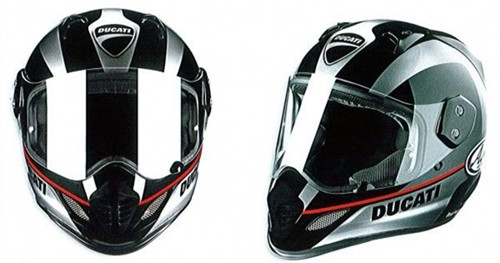
Qualified motorcycle occupant helmets must pass the certification test stipulated in the mandatory national standard "Motorcycle occupant helmets" (GB 811-2010) and pass the corresponding factory quality assurance ability audit before they can pass the mandatory product certification (CCC Certification). When choosing a helmet supplier, a motorcycle manufacturer can verify the factory's CCC certification and product quality test report; when purchasing a helmet, users can identify it by the "CCC" logo pasted on the helmet, do not use it without CCC certification Helmet.
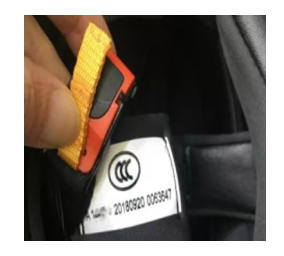
【Motorcycle occupant helmet covered by CCC certification】
Motorcycle occupant helmets are special equipment used to reduce occupant's head injuries in road traffic accidents. A helmet is usually composed of a shell, a buffer layer, a comfortable cushion, a wearing device, goggles, etc., where the shell and the buffer layer It is a key part of the helmet to absorb collision energy and protect the head from injury. Goggles can provide better protection for the eyes. Whether the wearing device is "reliable" will also have a direct impact on the helmet's protective effect.According to different shapes and structures, there are two types of helmets: full helmets and half helmets. The main difference between the two is the protection scope. Compared with half helmets, full helmets increase the protection of the lower jaw. According to different applicable objects, helmets can be divided into two categories: A helmets and B helmets. A helmets are suitable for motorcycles with a total displacement of more than 125cc. They are available in full helmets and half helmets; B helmets are suitable for general helmets. Motorcycles with a displacement of less than 125cc are smaller in volume and weight than Class A helmets, and all of them are half helmets. In general, the protection scope and protective performance of Class A helmets are better than those of Class B helmets.
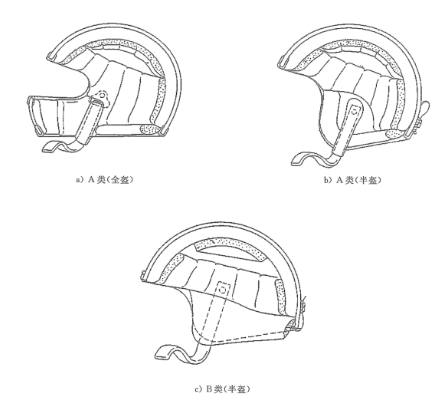
【National Standard for Motorcycle Helmets】
In order to standardize and improve the product quality of motorcycle occupant helmets, the Ministry of Public Security puts forward and is responsible for it. Our institute is responsible for formulating mandatory national standards for products. The current standard version is "Motorcycle occupant helmet" (GB 811-2010). From the perspective of guaranteeing the safety of occupants, the GB 811 standard puts forward a series of requirements such as the technical requirements and test methods of helmets.The CCC testing standard for motorcycle helmets "GB 811-2010 motorcycle occupant helmet", the specific testing items are as follows:
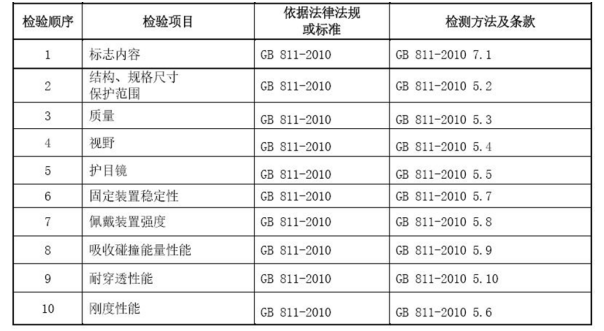
【Key performance of motorcycle occupant helmet】
Strict technical testing is the key link to ensure the quality and safety of the helmet. According to the requirements of "Motorcycle Occupant Helmet" (GB 811-2010), qualified motorcycle occupant helmets need to pass the "field of view", "goggles", "stiffness performance", "Collision energy absorption performance" and "penetration resistance performance" and other 10 items of the test, of which, "collision energy absorption performance" and "penetration resistance performance" are representative indicators of helmet safety protection performance.1. Ability to absorb collision energy
It mainly reflects the helmet's ability to absorb impact energy and reduce head injury when impacted. During the test, it is necessary to drop the helmet fixed on the head mold (simulating the human head) from a specified height, and assess 1 phenomenon and 2 technical parameters. Taking the A-type helmet as an example, the helmet shell must not crack after the test Phenomenon, the peak acceleration (characterizing the impact force) transmitted to the head model after collision should not exceed 300g, and the action time (characterizing the duration of noxious impact) when the acceleration exceeds 150g should be less than 4ms.

Crash test data
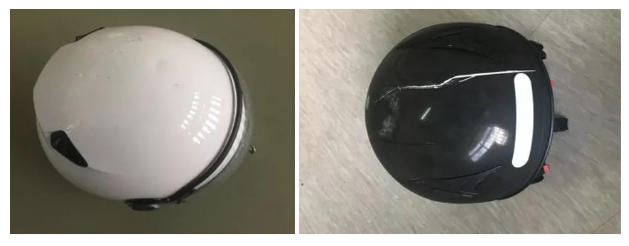
2. Penetration resistance
mainly reflects the helmet's ability to prevent damage to the head when it encounters sharp objects. In the test, a steel cone with a mass of 3 kg, a diameter of 25 mm, and a cone angle of 60° is used. The steel cone is dropped from a specified height (3 m for type A helmets) to carry out a penetration test on the helmet. After the test, the steel cone must not penetrate the helmet and come into contact with the head shape, and the helmet shell must not have cracks. The test results are shown in Figures 5 and 6.
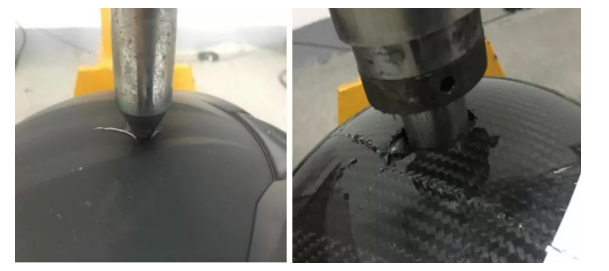
[CCC certification process for motorcycle helmets]
Step 1: Application for certificationStep 2: Type test (sample test)
Step 3: Evaluation and approval of certification results (review and certification)
Step 4: Initial factory inspection
It should be noted that after the CCC is certified, there is a supervision inspection (annual inspection) every year. Maintaining the CCC certification is a result of long-term work.
【CCC certification fees for motorcycle helmets】
Application fee: 500 yuan
Registration fee: 800 yuan
Test fee: according to the specific situation of the product
Initial factory inspection fee: generally 2500 yuan / day * 4 people
Because the test fee needs to be determined according to the specific parameters of the product to be inspected, etc., the specific fee can be confirmed by contacting our staff.
[CCC Certificate Template for Motorcycle Helmet]
The main reason why motorcycle helmets have evolved from production license management to mandatory certification (CCC certification) management is that these three types of products such as motorcycle helmets are directly related to human health and safety. Compulsory certification management is more conducive to protection Product quality and people's life safety. With the implementation of the mandatory 3C certification of domestic helmets, the quality of helmets is expected to pick up.
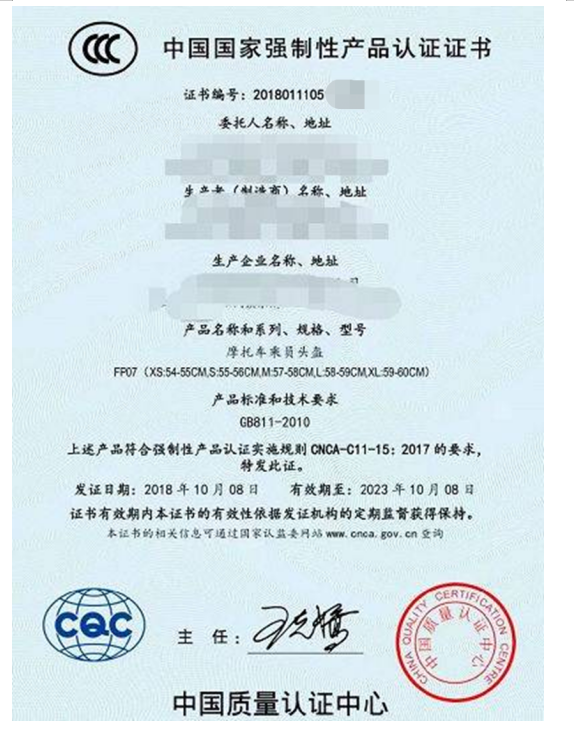
Add.:Room703、705/7F, Development Building, Tian An Hi-Teck Ecological Park, No.555 North Road Panyu Avenue, Panyu District, Guangzhou City, 511400, China
Tel.:020-39211670 Fax:020-39211640 E-mail:info@certitek.cn

